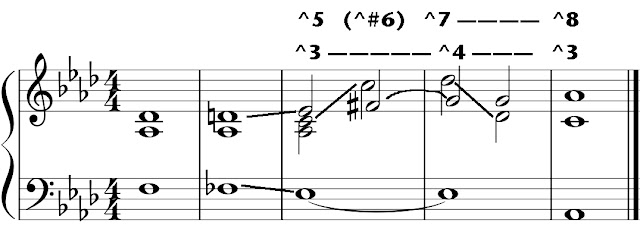The famous "Skaters Waltz" is
Les Patineurs by Emile Waldteufel (published in 1882). Given its main melody—the first strain of waltz n1—the notion of ascending cadences would seem far afield, but look at this simplified piano edition:
In a version for salon orchestra, the piano/conductor score (a two-stave score with abbreviated instrumental indications) also shows the rising scale figure from F#4 to A4. In the full orchestral score, this figure is taken by the second clarinet and second trumpet. The piano/conductor score, btw, shows the complete texture: there are no subsidiary parts or notes in different octaves.
Les Patineurs has an introduction, four waltzes, and a coda. The 16-bar main theme is anticipated in the introduction, appears twice in the first waltz (a small ternary design), and three times in the coda. The cadential counter-motive appears in all of these but the first (the introduction) and the last,
grandioso statement.
Looking at it in Schenkerian terms, three possible hearings are readily imagined. The first is a rising line from ^5, where an
Urlinie parallelism traces across the middleground in bars 2-10. The E4 (circled) in bar 11 is particularly interesting in that it clearly initiates a lower, descending line through the 4-3 figure over B2, but E4 is also an aural trace of the initial ^5 that prepares for the ascent that begins a bar later.
Alternatively, if we give full sway to hypermetric accent, that allows a hearing from ^3, with a neighbor in bar 5, a possible return to C# in bar 7, a consonant C# touched on at the end of bar 10 and a twice-dissonant C# at the end of bar 12 and in bar 13.
Combining the figures of both lines in a three-part
Ursatz design produces the following, quite satisfactory reading:
The problem is that the counter-motive is barely audible—to my aging ears, effectively inaudible—in all the recorded performances I listened to. The second clarinet and trumpet are simply overwhelmed by the unison melody in the first violins, cellos, and first clarinet and trumpet. In the end, then, if one is using Schenkerian tools, I think the best reading is this:
Note: I've left out one intermediate step, where the "quarter note" G#5 would have a C#4 below it and a bass C#3 (to account in some fashion for bars 7-8).
All in all, it must be said that this famous theme has a remarkable collection of diatonic dissonances.





















